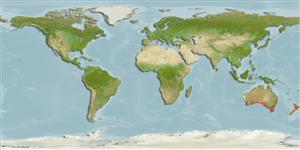Common names from other countries
Classification / Names / Names
俗名 | 同種異名 | Catalog of Fishes (gen., sp.) | ITIS | CoL | WoRMS
Environment: milieu / climate zone / depth range / distribution range
生態學
; 深度上下限 1 - 125 m (Ref. 74426).
Indo-West Pacific: Australia.
Length at first maturity / 大小 / 重量 / 年齡
Maturity: Lm ? range ? - ? cm
Life cycle and mating behavior
成熟度 | 繁殖 | 產卵場 | 卵 | 孕卵數 | 仔魚
Members of the order Amphipoda are gonochoric and sexually dimoprhic (males larger than females). Mating behavior: Males locate potential partners with the aid of their antenna to detect the pheromones released by the females; the male then rides or carries the female until the latter is ready to molt. When the female is ready, the male pushes the sperm into the marsupium and releases the female afterwards. A few hours later, the female releases her eggs into the marsupium for fertilization. Life cycle: Eggs are brooded in the marsupium. Eggs hatch into juveniles and remain in the marsupium for a few days. Each species undergo 20 molts at most, i.e., 1-year long life cycle.
主要參考資料
參考文獻 | 合作者 | 合作者
Lowry, J.K. 2007. (Ref. 74426)
IUCN 瀕危狀態 (Ref. 130435: Version 2024-1)
CITES狀態 (Ref. 108899)
Not Evaluated
Not Evaluated
對人類具威脅
人類使用
| FishSource |
工具
更多資訊
年龄/大小
成長
長度-重量
長度-長度
型態特徵
仔魚
豐度
網路資源
Estimates based on models
Preferred temperature
(Ref.
115969): 14.6 - 20.1, mean 17.1 (based on 298 cells).
